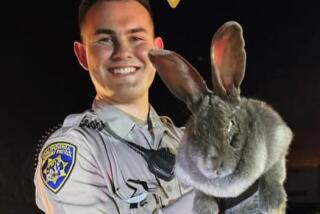Badly Injured Bobcat Is Back in the Hunt
- Share via
WINDSOR, Mass. — After months of recuperation in a 50-by-20-foot enclosure, a young bobcat badly injured in suburban traffic was set free. He quickly disappeared into pine woods only a few miles from his original range.
His six-month-long recovery gave veterinarians a coveted close-up view of a generally secretive animal that remains little known, even as some have slipped back into suburban woodlands.
“He’s just an incredible animal,” said Gretchen Kaufman, a veterinarian at the wildlife clinic run by the veterinary school at Tufts University, where the bobcat was treated.
Although bobcats are found everywhere in Massachusetts, except Cape Cod and the islands of Nantucket and Martha’s Vineyard, they are seldom seen.
Susan Langlois, a state biologist, said the last study of the animals was in the 1980s at the Quabbin Reservoir in central Massachusetts.
Kaufman said it was one of the few times her clinic has had the chance to treat a bobcat, especially one so seriously injured.
When it arrived at Tufts on Nov. 21 after emergency treatment by a Pittsfield veterinarian, the spotted cat, with drooping white mustache and a bob tail, had a shattered pelvis, broken canine teeth and multiple cuts from being struck by two cars.
At 25 pounds, the injured animal--an otherwise handsome male believed to be 2 years old--was of average size, according to Tom Keefe, a regional state wildlife official. At least several hundred of the fierce hunters make their home in the rocky crags of the Berkshire Hills of western Massachusetts, he said.
Stalking their solitary territories--those tracked at Quabbin Reservoir ranged two to five miles in a night--they can take deer, as well as smaller animals like rabbits, wood mice and voles.
But this injured bobcat was a long way from stalking anything when he arrived at Tufts.
An orthopedic surgeon at the school carefully pieced together the pelvic bones, which were broken in many places, with wire and plates and also inserted a hip pin.
“It makes for quite a dramatic X-ray,” said Kaufman. “And all that metal is still in him. But he could not have tolerated a cast.”
The bobcat lost so much blood during the operation that the veterinarians decided to attempt a transfusion. Kaufman said the animal’s blood type was checked, and domestic cat blood was used for the transfusion.
Some shattered teeth were pulled, and a root canal was necessary.
“He can still pick a pheasant carcass so clean, leaving only the bones, that it looks like the work of a taxidermist,” Kaufman said.
During his convalescence at Tufts, the cat roamed in his large enclosure equipped with climbing trees, logs and tall grass for hiding.
Finally, on May 15, the bobcat was released on a plateau in Windsor, about 10 miles northeast of Pittsfield and about three miles from his original range.
A spring shower swept across the mountains as a pair of Tufts students hauled the bobcat’s carrier down a rutted dirt road. The cat answered the distant thunder with a deep growl.
His carrier opened, he hesitated for a minute or two, then he scooted for the pines in a dappled gray streak. The horn-like trumpet of a startled red-bellied woodpecker marked his passage.
“It’s a good feeling,” said Pittsfield veterinarian Gerald Lemieux, who initially treated the animal after it was injured near a suburban mall.
More to Read
Sign up for Essential California
The most important California stories and recommendations in your inbox every morning.
You may occasionally receive promotional content from the Los Angeles Times.










